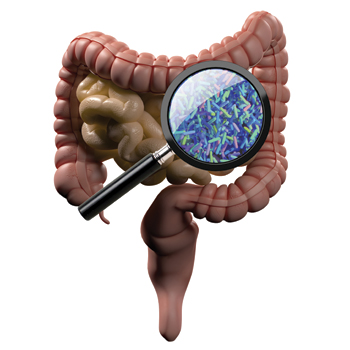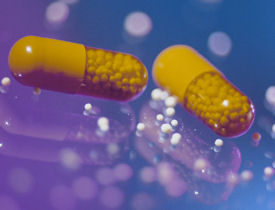Problems and potential with probiotics
Probiotics are becoming more prevalent in both consumer and health care settings, but the excitement is tempered by problems, including how to define what is and what isn't one.
As more patients probe the potential of probiotics, experts are tempering their excitement—at least for now.
The difficulties begin with defining probiotics. According to a 2001 consensus document from the World Health Organization and the Food and Agriculture Organization of the United Nations, they are live microorganisms that, when administered in adequate amounts, confer a health benefit to the host.

“If that definition raises a lot more questions than it answers for you, you're not alone,” ACP Member Krishna Rao, MD, an assistant professor of infectious diseases at the University of Michigan in Ann Arbor, said at IDWeek, held in October 2017 in San Diego.
During a session titled “Have a Yogurt and Call Me in the Morning: Update on Probiotics,” he pointed out that, using the accepted definition, yogurt isn't actually a probiotic. “They consider things like fermented foods with undefined microbial content and undefined consortia, such as fecal transplant, as not being in the probiotic framework,” Dr. Rao said. “The way to think about that is if you don't have evidence that it's a probiotic, it's not a probiotic; it's a biotic.”
Other challenges to wider use of probiotics in medicine include FDA regulation of research and uncertainties about potential risks. Still, the good bugs are becoming more prevalent in both consumer and health care settings, according to Dr. Rao and his co-presenter, Patricia Hibberd, MD, PhD, professor of medicine and pediatrics at Boston University School of Medicine.
“They're in an increasing number of foods and stores and, importantly, chocolate … so the bottom line is if somebody says they've never taken a probiotic, they're probably not correct,” said Dr. Hibberd.
Medical applications
There are some “exciting new approaches” to using probiotics in medicine, particularly in gastrointestinal disease, said Dr. Rao. The main commercially available probiotic organisms fall into three broad categories: Lactobacilli, Bifidobacteria, and yeasts (the most common being Saccharomyces).
At the University of Michigan, Lactobacillus is available in the formulary and is often used by gastroenterologists. “There are some decent data for Saccharomyces and Lactobacillus, for various strains, in preventing primary [Clostridium] difficile but also for recurrent C. difficile in a patient who is undergoing an episode,” said Dr. Rao.
Although data on probiotics are heterogeneous and many initial studies were uncontrolled, he pointed out promising results among hospitalized adults from a systematic review and meta-analysis published in 2017 in Gastroenterology. The review found a relative risk of about 0.42 to 0.62, depending on the sensitivity analysis, of C. difficile infection in probiotic users, with a number needed to treat of 43 to 63.
Dr. Hibberd, who is also chair and professor of the department of global health at the Boston University School of Public Health, clarified the contraindications of probiotics. Patients who are at higher risk of invasive infections and who should probably not receive probiotics include those with indwelling lines and short gut syndrome, as well as critically ill patients in ICUs and immunocompromised patients (particularly those on chemotherapy and with untreated HIV), she said.
There's also the issue that probiotics are often selected for their resistance to certain antibiotics, which can be a benefit. “This is something that a patient brought up when I talked to him and said, ‘If you're giving me those Saccharomyces or Lactobacilli, what's the point? Aren't they just going to die if I'm taking vancomycin?’” Dr. Rao said. “I had to explain to him that … it's resistant to that compound, and it's like a lightbulb went off.”
On the other hand, it's also a risk, noted Dr. Hibberd. “It may be an advantage if a probiotic is resistant to various antibiotics, but what if someone gets infected? What are you going to use to treat them?” she said.
Risks vary by bacterial or fungal strain but overall are not considered to be severe except in some patients, such as those whose immune system is compromised, according to Dr. Hibberd. “On balance, I think that if probiotics were causing very serious problems on a safety level, we'd know a lot more about it,” she said.
Ongoing research
Dr. Hibberd is one of those currently working to learn more about what probiotics do. She published a study in 2014 in PLoS One that used 16S rRNA sequencing to assess 15 older participants' responses to the same probiotic. In the phase 1, open-label study, participants took a twice-daily dose of 1010 Lactobacillus rhamnosus for 28 days.
“We showed quite a bit of variation to the way individuals alter their microbiomes, theoretically, in response to probiotics,” Dr. Hibberd said.
This is a relatively new field of study. Until about 2001, the word “microbiome” was almost not in use, said Dr. Hibberd. Since then, there have been many research papers and “an incredible explosion of the ability for us to understand organisms in the microbiome,” she said. “But what we really care about is what these bugs are doing. … We need to understand more than who's there, but what are they up to?”
The human microbiome contains an estimated 1014 of bacteria, particularly in the gastrointestinal tract, she explained. “In fact, we're made up of more bacteria than we are human cells, and if you actually then look at the genes that our human cells made versus the genes that the bacteria made, there's about a 100-fold advantage to the bacteria that live on us and in us,” she said.
Researchers also face regulatory challenges to studying probiotics, Dr. Hibberd said. The FDA's current approach to probiotics is that, when they are intended to prevent, mitigate, or cure any disease, they are considered a drug or biologic, subject to approval and regulation.
On the other hand, if the purported health benefit is structure or function (e.g., digestive health), the products do not need regulatory approval. “Consequently, this is why we hear mostly about what's called structure/function claims that really are unhelpful in terms of thinking about when and which [probiotics] to use,” she said.
Another issue is that some probiotic products in grocery stores may list unheard-of organisms. “Some of the ‘strains' in these products are actually not real bacteria at all; they are commercial names,” Dr. Hibberd said. “So that also makes things a lot more complicated.”
The dearth of certainty about probiotics doesn't make patients any less curious about them. “This is a huge market, and patients are losing patience [with doctors] because they can just go to the supermarket and get probiotics,” said Dr. Hibberd.
Although she is hesitant to make specific probiotic recommendations to her patients, she noted that referring them to the Clinical Guide to Probiotic Products can help. The 2017 edition of the guide, which is available online and as a mobile app, explains indications and current clinical evidence for specific probiotic organisms and brands.
The world will probably never see a large, robust efficacy study of different probiotics on the microbiome, said Dr. Hibberd. “There are too many of them, and it's just not going to happen,” she said. “But it is reasonable to use various probiotics, and for justification, I would recommend this particular guide.”




